Clustering of neuronal potassium channels is independent of their interaction with PSD-95
- PMID: 12438413
- PMCID: PMC2173099
- DOI: 10.1083/jcb.200206024
Clustering of neuronal potassium channels is independent of their interaction with PSD-95
Abstract
Voltage-dependent potassium channels regulate membrane excitability and cell-cell communication in the mammalian nervous system, and are found highly localized at distinct neuronal subcellular sites. Kv1 (mammalian Shaker family) potassium channels and the neurexin Caspr2, both of which contain COOH-terminal PDZ domain binding peptide motifs, are found colocalized at high density at juxtaparanodes flanking nodes of Ranvier of myelinated axons. The PDZ domain-containing protein PSD-95, which clusters Kv1 potassium channels in heterologous cells, has been proposed to play a major role in potassium channel clustering in mammalian neurons. Here, we show that PSD-95 colocalizes precisely with Kv1 potassium channels and Caspr2 at juxtaparanodes, and that a macromolecular complex of Kv1 channels and PSD-95 can be immunopurified from mammalian brain and spinal cord. Surprisingly, we find that the high density clustering of Kv1 channels and Caspr2 at juxtaparanodes is normal in a mutant mouse lacking juxtaparanodal PSD-95, and that the indirect interaction between Kv1 channels and Caspr2 is maintained in these mutant mice. These data suggest that the primary function of PSD-95 at juxtaparanodes lies outside of its accepted role in mediating the high density clustering of Kv1 potassium channels at these sites.
Figures
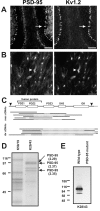
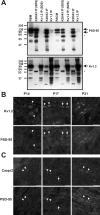
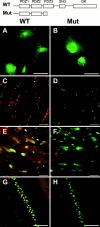
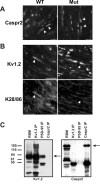
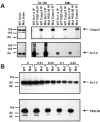

Similar articles
-
Multiple molecular interactions determine the clustering of Caspr2 and Kv1 channels in myelinated axons.J Neurosci. 2008 Dec 24;28(52):14213-22. doi: 10.1523/JNEUROSCI.3398-08.2008. J Neurosci. 2008. PMID: 19109503 Free PMC article.
-
ADAM22, a Kv1 channel-interacting protein, recruits membrane-associated guanylate kinases to juxtaparanodes of myelinated axons.J Neurosci. 2010 Jan 20;30(3):1038-48. doi: 10.1523/JNEUROSCI.4661-09.2010. J Neurosci. 2010. PMID: 20089912 Free PMC article.
-
Differential K+ channel clustering activity of PSD-95 and SAP97, two related membrane-associated putative guanylate kinases.Neuropharmacology. 1996;35(7):993-1000. doi: 10.1016/0028-3908(96)00093-7. Neuropharmacology. 1996. PMID: 8938729
-
It's "juxta" potassium channel!J Neurosci Res. 2004 Jun 15;76(6):749-57. doi: 10.1002/jnr.20073. J Neurosci Res. 2004. PMID: 15160387 Review.
-
Assembly and Function of the Juxtaparanodal Kv1 Complex in Health and Disease.Life (Basel). 2020 Dec 24;11(1):8. doi: 10.3390/life11010008. Life (Basel). 2020. PMID: 33374190 Free PMC article. Review.
Cited by
-
A toolbox of IgG subclass-switched recombinant monoclonal antibodies for enhanced multiplex immunolabeling of brain.Elife. 2019 Jan 22;8:e43322. doi: 10.7554/eLife.43322. Elife. 2019. PMID: 30667360 Free PMC article.
-
Spatiotemporal expression of PSD-95 and nNOS after rat sciatic nerve injury.Neurochem Res. 2008 Jun;33(6):1090-100. doi: 10.1007/s11064-007-9555-y. Epub 2007 Dec 20. Neurochem Res. 2008. PMID: 18095156
-
Juxtaparanodal clustering of Shaker-like K+ channels in myelinated axons depends on Caspr2 and TAG-1.J Cell Biol. 2003 Sep 15;162(6):1149-60. doi: 10.1083/jcb.200305018. Epub 2003 Sep 8. J Cell Biol. 2003. PMID: 12963709 Free PMC article.
-
Mechanisms and physiological implications of cooperative gating of clustered ion channels.Physiol Rev. 2022 Jul 1;102(3):1159-1210. doi: 10.1152/physrev.00022.2021. Epub 2021 Dec 20. Physiol Rev. 2022. PMID: 34927454 Free PMC article. Review.
-
Bridging the Molecular-Cellular Gap in Understanding Ion Channel Clustering.Front Pharmacol. 2020 Jan 29;10:1644. doi: 10.3389/fphar.2019.01644. eCollection 2019. Front Pharmacol. 2020. PMID: 32082156 Free PMC article. Review.
References
-
- Arroyo, E.J., and S.S. Scherer. 2000. On the molecular architecture of myelinated fibers. Histochem. Cell Biol. 113:1–18. - PubMed
-
- Arroyo, E.J., T. Xu, S. Poliak, M. Watson, E. Peles, and S.S. Scherer. 2001. Internodal specializations of myelinated axons in the central nervous system. Cell Tissue Res. 305:53–66. - PubMed
-
- Baba, H., H. Akita, T. Ishibashi, Y. Inoue, K. Nakahira, and K. Ikenaka. 1999. Completion of myelin compaction, but not the attachment of oligodendroglial processes triggers K+ channel clustering. J. Neurosci. Res. 58:752–764. - PubMed
-
- Bekele-Arcuri, Z., M.F. Matos, L. Manganas, B.W. Strassle, M.M. Monaghan, K.J. Rhodes, and J.S. Trimmer. 1996. Generation and characterization of subtype-specific monoclonal antibodies to K+ channel α- and β-subunit polypeptides. Neuropharmacology. 35:851–865. - PubMed
-
- Berghs, S., D. Aggujaro, R. Dirkx, E. Maksimova, P. Stabach, J.M. Hermel, J.P. Zhang, W. Philbrick, V. Slepnev, T. Ort, and M. Solimena. 2000. βIV spectrin, a new spectrin localized at axon initial segments and nodes of Ranvier in the central and peripheral nervous system. J. Cell Biol. 151:985–1002. - PMC - PubMed
Publication types
MeSH terms
Substances
Grants and funding
LinkOut - more resources
Full Text Sources
Molecular Biology Databases
Miscellaneous

